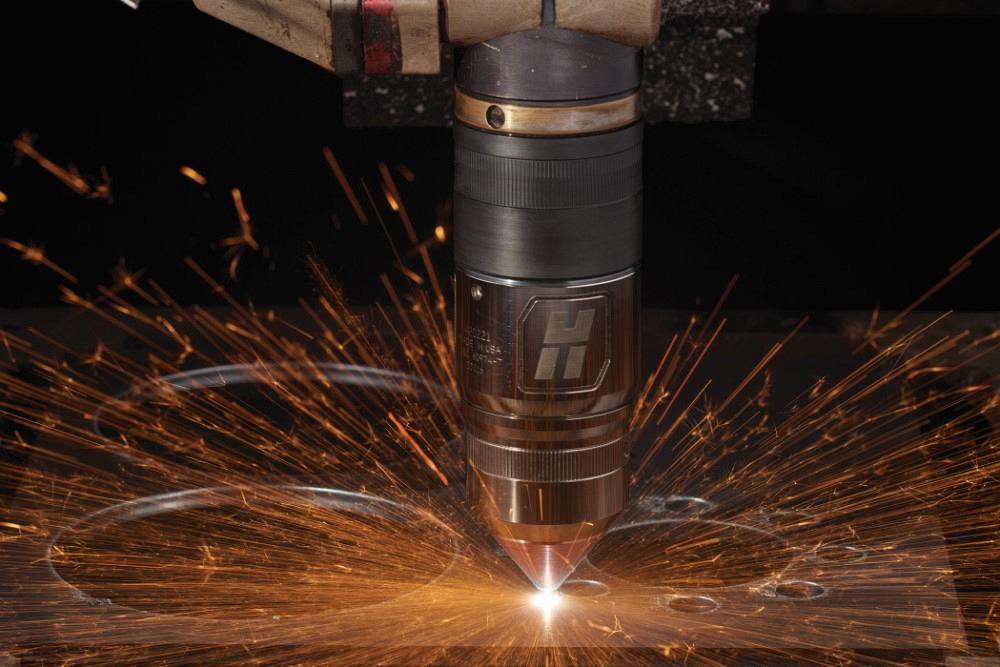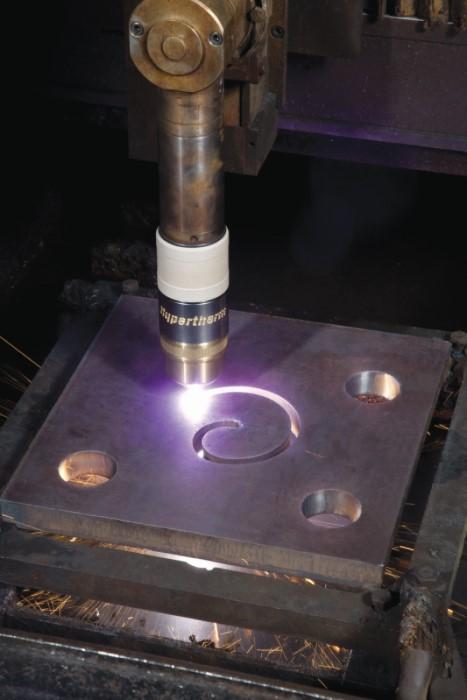Consultant
- FMA
- The Fabricator
- FABTECH
- Canadian Metalworking
Categories
- Additive Manufacturing
- Aluminum Welding
- Arc Welding
- Assembly and Joining
- Automation and Robotics
- Bending and Forming
- Consumables
- Cutting and Weld Prep
- Electric Vehicles
- En Español
- Finishing
- Hydroforming
- Laser Cutting
- Laser Welding
- Machining
- Manufacturing Software
- Materials Handling
- Metals/Materials
- Oxyfuel Cutting
- Plasma Cutting
- Power Tools
- Punching and Other Holemaking
- Roll Forming
- Safety
- Sawing
- Shearing
- Shop Management
- Testing and Measuring
- Tube and Pipe Fabrication
- Tube and Pipe Production
- Waterjet Cutting
Industry Directory
Webcasts
Podcasts
FAB 40
Advertise
Subscribe
Account Login
Search
Mechanized plasma cutting four ways
Air plasma, conventional plasma, high-definition, and ultrahigh-definition technologies developments improve versatility
- By Jim Colt
- June 2, 2021
- Article
- Plasma Cutting

Plasma cutting technology can be divided into four distinct categories: air plasma, conventional plasma, high-definition, and ultrahigh-definition. Each offers different advantages and lends itself well to many applications and capabilities. Images: Hypertherm
The plasma cutting process is best-known for its simplicity and its ability to cut nearly any metal. These qualities, plus the productivity it yields, have made plasma cutting a universally accepted metal cutting process with a range of capabilities and applications.
Plasma Technologies
Used commercially since the 1960s, the plasma cutting process with its flexibility lends itself well to many applications and capabilities. Motion-control devices such as CNC cutting machines, punch plasma machines, industrial robots, and pipe cutting machines aside, the plasma process can be categorized into four distinct categories: air plasma, conventional plasma, high-definition, and ultrahigh-definition.
Air Plasma. Originally designed for hand-held torch cutting, air plasma systems use compressed air as the plasma gas, making them relatively easy and inexpensive to operate. They are available in power level outputs as low as 12 amps with a maximum cutting thickness of 1⁄8 in. all the way up to 125 amps with a cutting capacity of 1-1/2 in. Most of these systems use inverter power supply technology, which makes them portable. Many are available with a machine torch and have electrical interfaces for use in mechanized cutting applications as well, such as on a CNC table.
Conventional Mechanized Plasma. Typically, the plasma systems in this category use a single gas—either air or oxygen—and are available only with machine-mountable torches. Also, they generally have more complex interfaces to provide better performance when used in modern CNC cutting machine applications. Power levels for conventional mechanized plasma systems range from 130 amps to as high as 1,000 amps.
Designed for high productivity with midlevel tolerances for cutting nonferrous (stainless and aluminum) materials up to 6-1⁄4 in. thick, these systems are the workhorses of steel service centers, shipyards, and heavy-equipment manufacturers. While some manufacturers have put the engineering effort into improving this class of systems, they largely remain similar to the conventional industrial cutting machines that have been in use for the past few decades.
High-definition Plasma.High-production sheet and plate cutting is the category that is receiving the most attention in terms of process research and development. As a result, high-definition plasma cutting systems made huge strides in quality, speed, power level, operating costs, and most recently ease of use since their introduction in the early 1990s.
With high-definition plasma cutting, the plasma arc is forced through a smaller nozzle orifice, taking full advantage of the laws of high-temperature physics. This made for cleaner, squarer cut edges when compared to air and conventional plasma cutting, while maintaining acceptable consumable parts life in the torch. Today’s class of high-definition plasma systems are available between 130 and 800 amps and can cut from 26 ga. to 3 in. on carbon steel and up to 6-1⁄4 in. on stainless and aluminum.
Ultrahigh-definition Plasma.This class of plasma, sometimes called X-Definition, produces consistent results on ISO Range 2 when cutting mild steel and extended ISP Range 3 results compared with regular high-definition plasma cutting. Based on ISO 9013, an international standard that defines the quality of thermally cut parts from 1 to 5 with Range 1 considered best, ultrahigh-definition plasma can deliver ISO Range 2 cuts on thin steel at low current settings.
Those cutting thicker mild steel (3/4 in. thick) will achieve ISO Range 3 cut quality for nearly the entire lifespan of the consumables. These cut quality improvements span across all metal types, including aluminum and stainless steel.
In addition, the cut quality with ultrahigh-definition plasma is more uniform than with other types of plasma. During testing, engineers have found that a part cut with brand-new consumables looked pretty much identical to a part cut using consumables with more than 1,000 starts on them.

Plasma cutting technology can be divided into four distinct categories: air plasma, conventional plasma, high-definition, and ultrahigh-definition. Each offers different advantages and lends itself well to many applications and capabilities.
Technology Updates
It has always been known that machine motion (accuracy, acceleration, and smoothness), torch height control (pierce height, cut height, collision avoidance, and cycle times), and CAM software (postprocessing for kerf width, lead-ins, lead-outs, and nesting) play major roles that affect any mechanized cutting operation in terms of cut part accuracy, operating cost, and throughput. The parameters associated with each of these external systems were historically controlled by the programmer and machine operator.
An astute operator needed to pay attention to the multiple setup parameters required for consistent cut quality from day to day. This might include constant monitoring of arc voltage, gas flow, and pressure, as well as a dozen others to produce the best cut quality as power level, material thickness, and consumable parts in the torch change. The result is that a cutting operation with an expert programmer and an experienced operator could be expected to produce higher quality than an operation with less attentive or less experienced staff.
Armed with the knowledge that controlling the dozens of critical operating parameters affecting all levels of plasma performance more tightly and consistently would further improve the cutting processes on the shop floor, system engineers went to work. The manufacturers of these systems worked intimately with the providers of the machine CNCs, the torch height controls, and the CAD software (often called nesting software). After a few years of development work, the newest plasma systems use the full suite of CNC cutting machine components to fully automate and coordinate the functions that affect cut quality.
These plasma systems now can accept the same AutoCAD-format drawing file inputs that older machines use and incorporate newer CAM software to analyze features on the part drawings such as holes, external features, shape, material type, and thickness. This analysis then is used to nest the parts; insert the best lead-ins/lead-outs, cut speed, amperage, and gases; and set all of the cutting parameters that were once controlled by the machine operator.
The result is high-quality plasma-cut parts; round, taper-free holes; consistent cut quality; less downtime because of plate collision-avoidance technology; less scrap because of fewer or no setup errors by the operator or programmer; and faster cut-to-cut cycle times. CNC technology advancements employ Windows-based touchscreen operator controls that are simple to use, greatly reducing a new machine operator’s learning curve.
About the Author
About the Publication
Related Companies
subscribe now

The Welder, formerly known as Practical Welding Today, is a showcase of the real people who make the products we use and work with every day. This magazine has served the welding community in North America well for more than 20 years.
start your free subscription- Stay connected from anywhere

Easily access valuable industry resources now with full access to the digital edition of The Fabricator.

Easily access valuable industry resources now with full access to the digital edition of The Welder.

Easily access valuable industry resources now with full access to the digital edition of The Tube and Pipe Journal.
- Podcasting
- Podcast:
- The Fabricator Podcast
- Published:
- 04/16/2024
- Running Time:
- 63:29
In this episode of The Fabricator Podcast, Caleb Chamberlain, co-founder and CEO of OSH Cut, discusses his company’s...
- Industry Events
16th Annual Safety Conference
- April 30 - May 1, 2024
- Elgin,
Pipe and Tube Conference
- May 21 - 22, 2024
- Omaha, NE
World-Class Roll Forming Workshop
- June 5 - 6, 2024
- Louisville, KY
Advanced Laser Application Workshop
- June 25 - 27, 2024
- Novi, MI
































